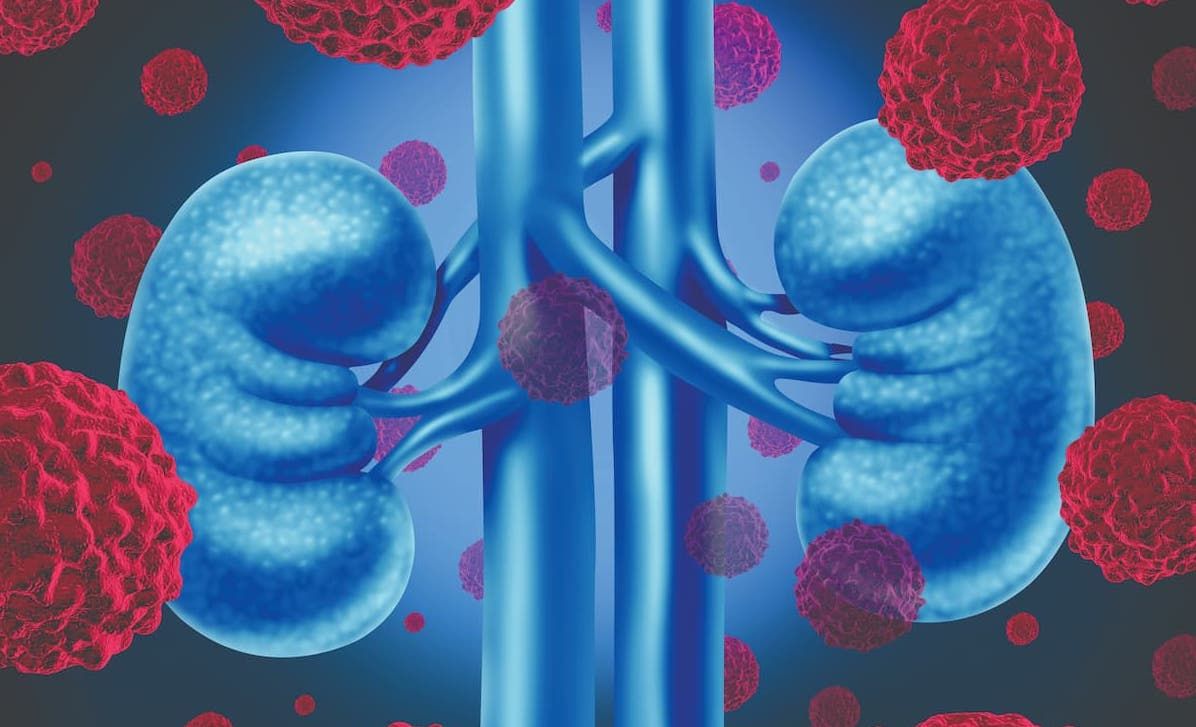Benmelstobart Combo Improves Outcomes Vs Sunitinib in Advanced RCC
Phase 3 data support benmelstobart/anlotinib as a new potential standard in the frontline treatment of patients with advanced renal cell carcinoma.
“Based on our findings, we believe that benmelstobart in combination with anlotinib has the potential to become a new standard first-line treatment for advanced RCC,” according to study author Xinan Sheng, MD.

Clinical outcomes improved among patients with advanced renal cell carcinoma (RCC) who received first-line benmelstobart (TQB2450) plus anlotinib (AL3818) compared with sunitinib (Sutent), according to data from the phase 3 ETER100 trial (NCT04523272) presented at the 2024 European Society for Medical Oncology (ESMO) Congress.1
Patients in the combination arm (n = 264) achieved a median progression-free survival (PFS) by blinded independent central review (BICR) of 18.96 months (95% CI, 15.34-22.83) vs 9.76 months (95% CI, 8.38-12.42) in the sunitinib arm (n = 263; HR, 0.53; 95% CI, 0.42-0.67; P < .0001). The median overall survival (OS) was not estimable (NE; 95% CI, 38.18-NE) compared with NE (95% CI, 30.49-NE), respectively (HR, 0.66; 95% CI, 0.48-0.92; P = .0673). The respective overall response rates (ORRs) by BICR were 71.6% vs 25.1%; 1.1% of patients in the combination arm achieved a complete response.
“Based on our findings, we believe that benmelstobart in combination with anlotinib has the potential to become a new standard first-line treatment for advanced RCC,” Xinan Sheng, MD, of Peking University Cancer Hospital and Institute in Beijing, China, said during the presentation. “At the [data cutoff] date, [findings from] the analysis showed a significant improvement in the combination arm over the sunitinib arm. The combination treatment reduced the risk of progression or death by 47% compared with sunitinib.”
Design of the ETER100 Study
ETER100 was a positive parallel controlled, multicenter study that enrolled patients with locally advanced or metastatic clear cell RCC who did not undergo prior systemic antitumor therapy. To be eligible for the study, patients needed to be 18 to 80 years of age, have an ECOG performance status of 1 or less, and have at least 1 measurable lesion per RECIST 1.1 criteria. Patients with prior exposure to any VEGFR-directed TKIs or immune checkpoint inhibitors were excluded.1,2
Patients were randomly assigned 1:1 to receive anlotinib 12 mg daily on days 1 to 14 every 3 weeks plus benmelstobart 1200 mg on day 1 every 3 weeks or sunitinib 50 mg daily on days 1 through 28 every 6 weeks. Patients were stratified by IMDC risk group (favorable vs intermediate vs poor). Treatment in both arms continued until disease progression or intolerable toxicity.1
The primary end point was PFS by BICR per RECIST 1.1 criteria. Secondary end points included investigator-assessed PFS, OS, ORR, disease control rate, duration of response, and safety.
The baseline characteristics were well balanced between the 2 arms; the median age in the combination arm was 60.5 years (range, 54.0-67.0) vs 59.0 years (range, 54.0-67.0) in the sunitinib arm. Most patients in both arms were less than 65 years old (64.02% vs 69.20%), male (77.27% vs 74.52%), had an ECOG performance status of 1 (72.73% vs 73.76%), had IMDC intermediate risk disease (71.21% vs 71.86%), and underwent a prior nephrectomy (66.67% vs 66.16%). Sites of disease metastasis included the lung (62.50% vs 60.84%), bone (21.59% vs 20.53%), and liver (13.26% vs 10.27%), in the combination vs sunitinib arm, respectively.
Additional Findings from ETER100
Findings from a subgroup analysis showed that the PFS benefit observed with anlotinib plus benmelstobart vs sunitinib was sustained across all subgroups. The most pronounced benefit reported was among patients with sarcomatoid differentiation (HR, 0.33; 95% CI, 0.08-1.26) and those with liver metastasis (HR, 0.44; 95% CI, 0.23-0.85).
In terms of safety, patients in the investigational and control arms both experienced any-grade treatment-emergent adverse effects (TEAEs) at rates of 99.24%. Patients in both arms also had grade 3 or higher TEAEs (75.00% vs 74.62%), any-grade treatment-related adverse effects (TRAEs; 98.11% vs 98.11%), grade 3 or higher TRAEs (67.42% vs 65.91%), and serious AEs (38.64% vs 28.03%), respectively. Additionally, patients in the combination arm experienced immune-related AEs (33.33%), grade 3 or higher immune-related AEs (9.47%), and immune-related reactions (4.92%).
One-hundred and thirty-eight patients in the combination arm discontinued treatment due to disease progression (n = 84), AEs (n = 12), patient withdrawal (n = 6), death (n = 17), lost to follow-up (n = 3), and other reasons (n = 16). Among patients in the sunitinib arm, 209 discontinued treatment due to disease progression (n = 142), AEs (n = 12), patient withdrawal (n = 21), death (n = 8), lost to follow-up (n = 1) and other reasons (n = 25).
“The addition of benmelstobart to anlotinib as a first-line treatment for [patients with] advanced RCC provided superior clinical outcomes compared with sunitinib,” Sheng said in conclusion. “The combination was generally well-tolerated, with a safety profile consistent with each agent.”
Disclosures: Sheng has consulting or advisory roles with Pfizer, Novartis, Astellas, AstraZeneca, Bayer, MSD, RemeGen, and Junshi Biosciences.
References
- Sheng X, Shen P, Qu W, et al. Anlotinib in combination with anti–PD-L1 antibody benmelstobart (TQB2450) versus sunitinib in first-line treatment of advanced renal cell carcinoma (RCC). Presented at: 2024 ESMO Congress; September 13-17, 2024; Barcelona, Spain. Abstract LBA76.
- A study of TQB2450 injection combined with anlotinib hydrochloride capsule versus sunitinib in subjects with advanced renal cancer. ClinicalTrials.gov. Updated September 10, 2020. Accessed September 15, 2024. https://clinicaltrials.gov/study/NCT04523272